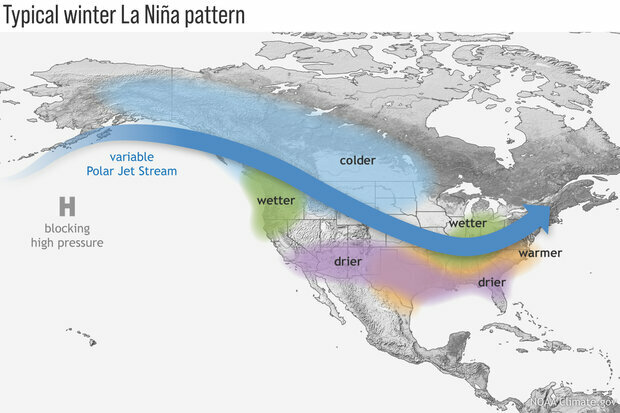 During La Niña, the Pacific jet stream often meanders high into the North Pacific. Southern and interior Alaska and the Pacific Northwest tend to be cooler and wetter than average, and the southern tier of U.S. states — from California to the Carolinas — tends to be warmer and drier than average. Farther north, the Ohio and Upper Mississippi River Valleys may be wetter than usual. Climate.gov image[/caption]
During La Niña, the Pacific jet stream often meanders high into the North Pacific. Southern and interior Alaska and the Pacific Northwest tend to be cooler and wetter than average, and the southern tier of U.S. states — from California to the Carolinas — tends to be warmer and drier than average. Farther north, the Ohio and Upper Mississippi River Valleys may be wetter than usual. Climate.gov image[/caption] When El Niño and La Niña get thrown around, it can be hard to keep track of which means more snow. As if all children keep to their promises, scientists predict colder and wetter conditions in the Pacific Northwest during La Niña winters. Hopefully, that remains true for the upcoming season.
Ocean and atmospheric conditions show that the cool phase of the El Niño Southern Oscillation (ENSO) climate pattern, also known as La Niña, is already at play in the tropical Pacific, according to a September 8 ENSO blog post. Scientists say this gives a 91 percent chance of La Niña from September to November and an 80 percent chance through early winter, November to January.
The August sea surface temperature at ENSO’s primary monitoring location was 1.8 degrees Fahrenheit (1.0 degrees Celsius) cooler than the long-term average, which is substantially cooler than the La Niña threshold of 0.9 degrees Fahrenheit (0.5 degrees Celsius) below average. ENSO also reports cooler-than-average water under the surface of the eastern-central tropical Pacific.
The ENSO blog monitors and forecasts El Niño, La Niña and their impacts on National Oceanic and Atmospheric Administration (NOAA) website Climate.gov.
Scientists agree La Niña will make it to winter but do not know how long it may last. About 54 percent give La Niña the edge from January to March. There’s, however, a 56 percent of neutral from February to April.
While La Niña typically results in wetter and snowier conditions in northern U.S., it has varying impacts on other regions.
Winters tend to be drier in southern U.S., hotter and drier summers in Texas following La Niña winters, more frequent spring hailstorms and tornadoes in south-central U.S., rainier winters in Hawaii and cooler, wetter winters in Alaska. La Niña may also reduce atmospheric rivers on the West Coast, according to the blog, and increase Atlantic hurricane season activity, which can be seen with Hurricane Ian hitting Florida.
Mt. Baker Ski area season tickets go on sale at 7 a.m. October 1 in the open purchase window. The ski resort will announce September 30 if any season tickets are still available. The sale window closes once the cap is reached.